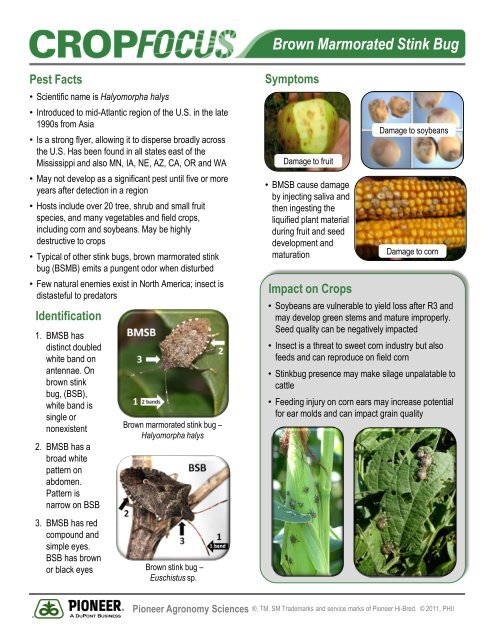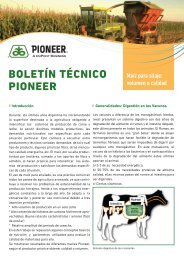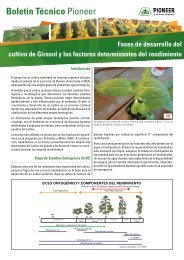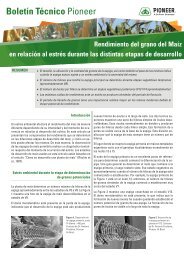Brown Marmorated Stink Bug Lifecycle - Pioneer
Brown Marmorated Stink Bug Lifecycle - Pioneer
Brown Marmorated Stink Bug Lifecycle - Pioneer
You also want an ePaper? Increase the reach of your titles
YUMPU automatically turns print PDFs into web optimized ePapers that Google loves.
<strong>Brown</strong> <strong>Marmorated</strong> <strong>Stink</strong> <strong>Bug</strong><br />
Pest Facts<br />
• Scientific name is Halyomorpha halys<br />
• Introduced to mid-Atlantic region of the U.S. in the late<br />
1990s from Asia<br />
• Is a strong flyer, allowing it to disperse broadly across<br />
the U.S. Has been found in all states east of the<br />
Mississippi and also MN, IA, NE, AZ, CA, OR and WA<br />
• May not develop as a significant pest until five or more<br />
years after detection in a region<br />
• Hosts include over 20 tree, shrub and small fruit<br />
species, and many vegetables and field crops,<br />
including corn and soybeans. May be highly<br />
destructive to crops<br />
• Typical of other stink bugs, brown marmorated stink<br />
bug (BSMB) emits a pungent odor when disturbed<br />
• Few natural enemies exist in North America; insect is<br />
distasteful to predators<br />
Identification<br />
1. BMSB has<br />
distinct doubled<br />
white band on<br />
antennae. On<br />
brown stink<br />
bug, (BSB),<br />
white band is<br />
single or<br />
nonexistent<br />
2. BMSB has a<br />
broad white<br />
pattern on<br />
abdomen.<br />
Pattern is<br />
narrow on BSB<br />
3. BMSB has red<br />
compound and<br />
simple eyes.<br />
BSB has brown<br />
or black eyes<br />
<strong>Brown</strong> marmorated stink bug –<br />
Halyomorpha halys<br />
<strong>Brown</strong> stink bug –<br />
Euschistus sp.<br />
Symptoms<br />
Damage to fruit<br />
• BMSB cause damage<br />
by injecting saliva and<br />
then ingesting the<br />
liquified plant material<br />
during fruit and seed<br />
development and<br />
maturation<br />
Impact on Crops<br />
Damage to soybeans<br />
Damage to corn<br />
• Soybeans are vulnerable to yield loss after R3 and<br />
may develop green stems and mature improperly.<br />
Seed quality can be negatively impacted<br />
• Insect is a threat to sweet corn industry but also<br />
feeds and can reproduce on field corn<br />
• <strong>Stink</strong>bug presence may make silage unpalatable to<br />
cattle<br />
• Feeding injury on corn ears may increase potential<br />
for ear molds and can impact grain quality<br />
<strong>Pioneer</strong> Agronomy Sciences ®, TM, SM Trademarks and service marks of <strong>Pioneer</strong> Hi-Bred. © 2011, PHII
<strong>Brown</strong> <strong>Marmorated</strong> <strong>Stink</strong> <strong>Bug</strong> <strong>Lifecycle</strong><br />
• Develop with incomplete metamorphosis – egg, five instars and adult stage<br />
• Eggs are “beer-barrel” shaped, laid in clusters<br />
• <strong>Brown</strong> to black nymphs congregate after hatching<br />
• Nymphs lack fully developed wings<br />
Eggs<br />
Nymph<br />
Adults<br />
Winter<br />
Fall<br />
Overwinter<br />
as adults in<br />
protected areas,<br />
including homes<br />
March-<br />
April<br />
Three generations<br />
in south;<br />
One in north<br />
July-<br />
August<br />
Leave fields<br />
for protected<br />
areas such as<br />
houses or<br />
heavy cover<br />
Management Considerations<br />
• Scout soybeans from R2 till mid-August<br />
• Scout especially field edges and treat them separately<br />
if warranted (see photo at bottom right)<br />
• In soybean the threshold is 2.5 to 3.5 brown<br />
marmorated stink bugs every 15 sweeps<br />
• Populations will be highest at dusk and dawn, and<br />
reinvasion is possible after a pesticide treatment<br />
• Many insecticides are labeled for stink bug control,<br />
however, BMSB may be more tolerant of many<br />
pesticides than other stinkbugs<br />
• Nymphs are more sensitive to insecticides than adults<br />
• Check local control recommendations and always<br />
read and follow label instructions<br />
Image credits:<br />
Rutgers University<br />
Dr. Galen Dively, University of Maryland<br />
Drs. Tracy Leskey & Jeff Wildonger, USDA-ARS<br />
Dr. Marlin Rice, <strong>Pioneer</strong> Hi-Bred<br />
Dr. Doug Inkley, NWF<br />
Further References<br />
• http://stream.ucanr.org/fps_stinkbug/index.html<br />
• http://extension.usu.edu/files/publications/factsheet/<br />
bmsb-5-11.pdf<br />
• http://www.grapesandfruit.umd.edu/Pages/EffectiveI<br />
nsecticidesBMSB_02072011.pdf<br />
Green soybeans along field edge showing delayed<br />
maturity (green stem syndrome) due to BSMB feeding.<br />
<strong>Pioneer</strong> Agronomy Sciences ®, TM, SM Trademarks and service marks of <strong>Pioneer</strong> Hi-Bred. © 2011, PHII









